King of Antioxidants?
WHAT IS ASTAXANTHIN? AstaReal What is Astaxanthin
Red power for your health & beauty
Highly powerful antioxidant
Astaxanthin is a potent nutrient, well known for its vibrant red color.
It has gained attention from health and food industry leaders for its high antioxidant power, anti-inflammatory action, and wide range of health benefits.
But astaxanthin is not just a powerful antioxidant. From our recent research, it revealed that astaxanthin activates mitochondrial function and enhances the biogenesis of mitochondria. (1) This finding is enlightening further the potential of this remarkable nutrient.
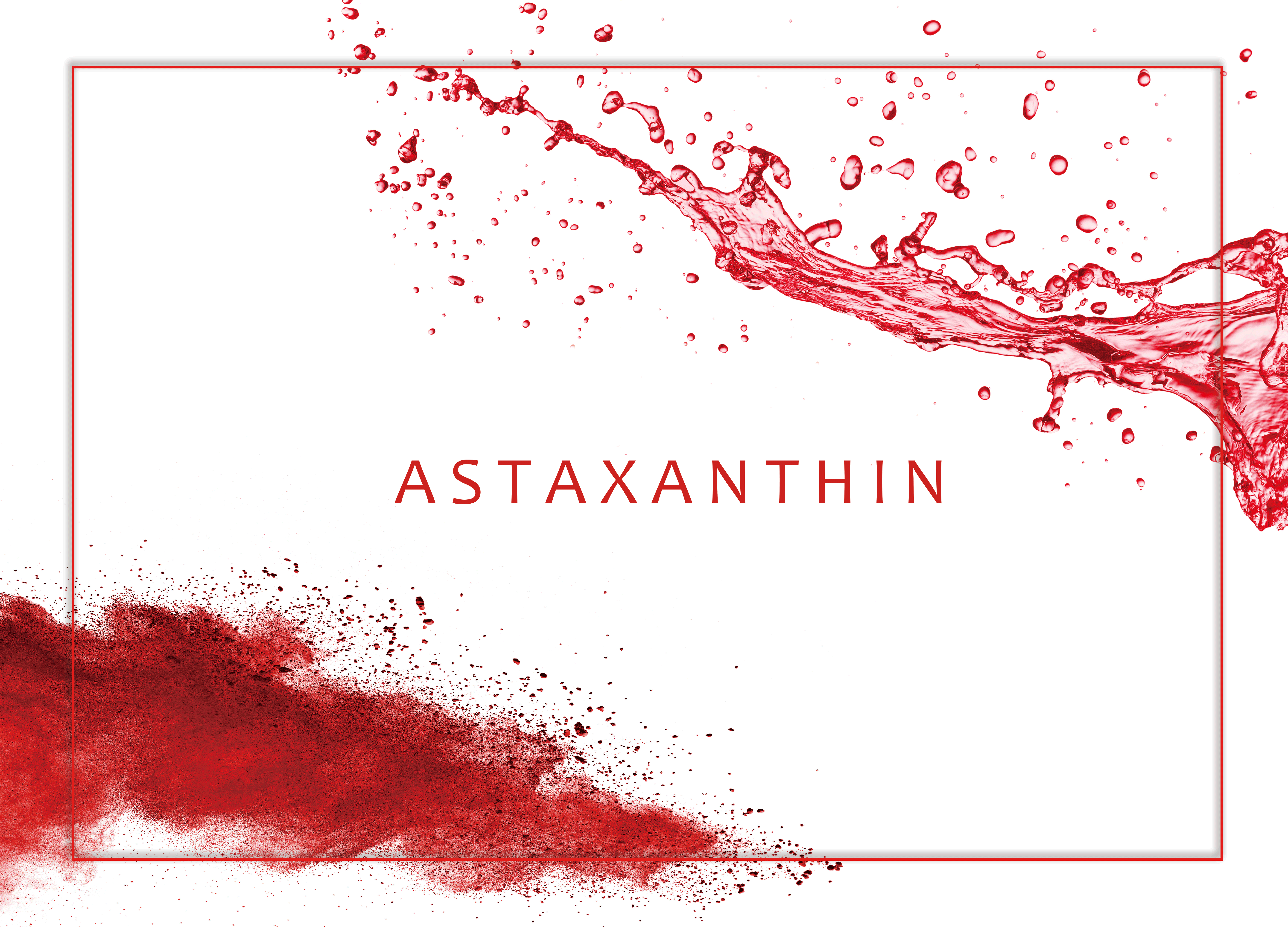
1. Strong Antioxidant Power
Astaxanthin Astaxanthin belongs to the carotenoid family, and studies proved it has greater antioxidant capacity than the other popular carotenoids such as beta carotene, lycopene, and lutein. Thus it is often called ‘The King of Carotenoids’ . Among the 730 carotenoids, astaxanthin has the strongest antioxidant power to quench singlet oxygen.(2)
Singlet Oxygen is one of the most harmful reactive oxygen species (ROS) generated by UVA irradiation of our cells and skins, and directly damages biological lipids, proteins, and DNA. These damages may cause not just photo-aging (like age spots and wrinkles) but also a significant increase in the risk of carcinogenesis in the skin and cataract formation of the eye lens. Astaxanthin quenches singlet oxygen and protects our body from UVA-induced damage.
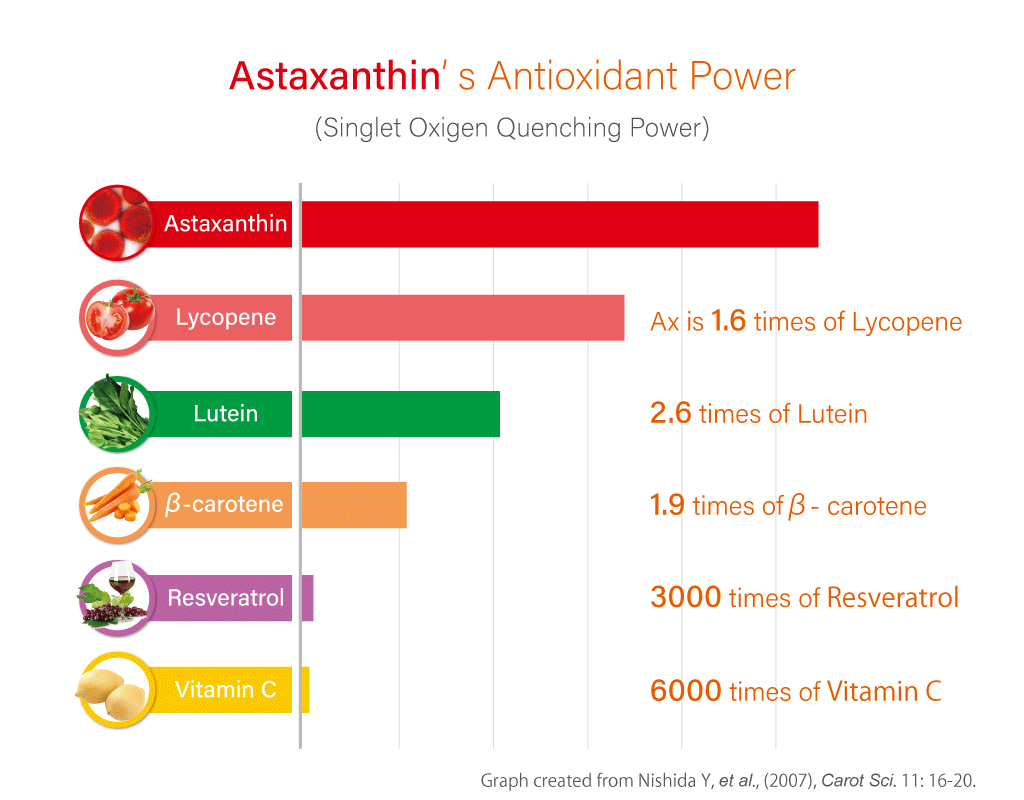
2. Pure Antioxidant
Astaxanthin stands out as it’s a ‘Pure Anti-oxidant’ . It is known that many well known antioxidants such as Vitamin C and Vitamin E become pro-oxidant under intense oxidative stress, and induce oxidative damage as opposed to preventing those.
Unlike those antioxidants that show pro-oxidant activity, astaxanthin is a very rare antioxidant that can continue to quench ROS safely without any pro-oxidant activity even under expressive oxidative stress.(3)
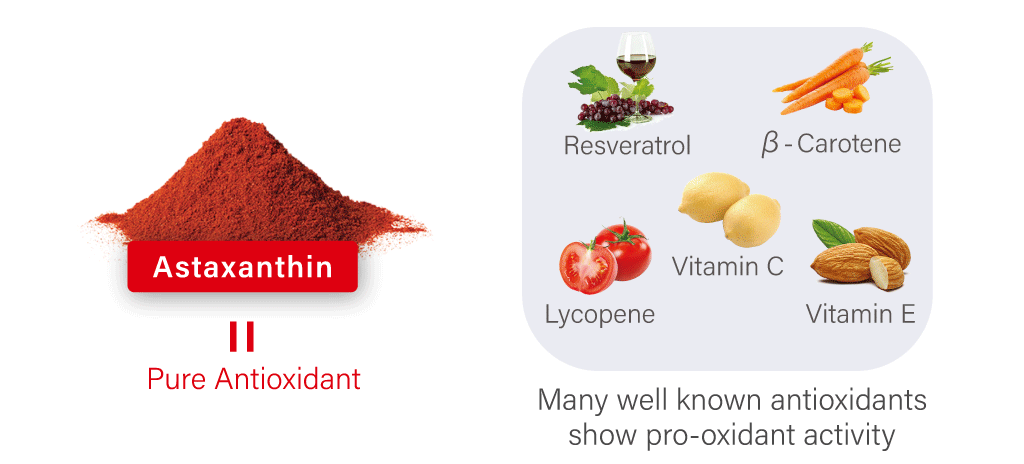
3. Advanced Cell Membrane Protection
Superior positioning of astaxanthin in the cell membrane
The secret to astaxanthin’s high antioxidant potency lies in its unique chemical structure and superior positioning across the cell membrane. Human cell membranes are made up of two layers, the outer and inner layers. The outside layer is water-soluble (hydrophilic) and the inside is lipid-soluble (hydrophobic).(4)
Most antioxidants are classified as either hydrophilic or hydrophobic and can only work in either area of the body. For example, Vitamin C is hydrophilic so works in the hydrophilic area (cell exterior), and beta-carotene in the hydrophobic area (inside membrane).
Astaxanthin is originally lipid-soluble=hydrophobic but has hydrophilic ends at both sides of its structure, so it spans across the membrane and quenches ROS on both surface and inside of the cells. This transmembrane orientation enables astaxanthin to provide complete cellular protection from both extracellular and intracellular ROS attacks.
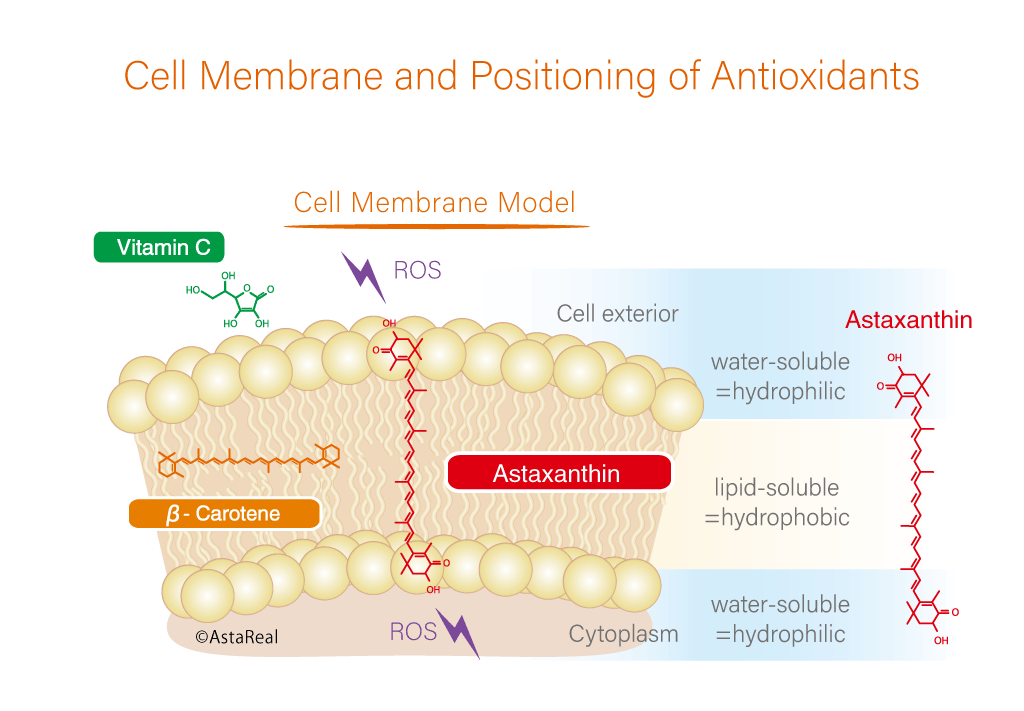
Why do the cell membranes need astaxanthin’s protection?
 The cell membrane protects vital components such as mitochondria
and DNA, and maintains the physical integrity of the cell.
The cell membrane protects vital components such as mitochondria
and DNA, and maintains the physical integrity of the cell.  Cell membranes can be easily damaged without a strong antioxidant defense. Oxidative stress may cause the onset of a variety of diseases and cause DNA damage.
Cell membranes can be easily damaged without a strong antioxidant defense. Oxidative stress may cause the onset of a variety of diseases and cause DNA damage.

4. Unique Mitochondrial Nutrient
Astaxanthin protects & activates mitochondria, the power plant of the cell from ROS.
Mitochondria are cellular organelles producing 90% of the cells’ energy, by converting oxygen and nutrients into energy in the form of ATP. Hundreds to thousands of mitochondria exist in a single cell, especially in organs that require a large amount of energy, such as the brain, heart, and muscle cells. Since they also generate ROS as a byproduct in this energy production process, we need to protect them from ROS attacks to regulate their function.
Astaxanthin provides advanced protection of mitochondria from ROS, enhances ATP production, and promotes the biogenesis of new mitochondria.
In 2020 our research team found that astaxanthin stimulates mitochondrial biogenesis in insulin-resistant muscle via activation of the AMPK pathway(5). This finding shows the potential of astaxanthin for diabetes treatment and what makes astaxanthin more unique.
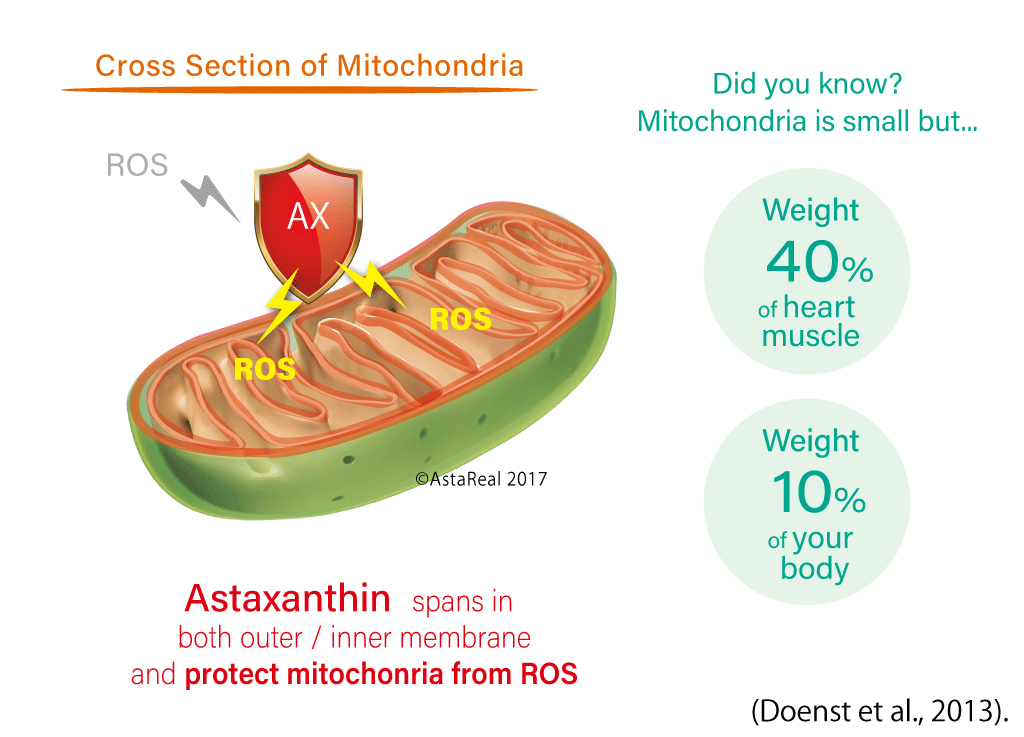
5. Potent Anti-inflammatory
Astaxanthin has outstanding anti-inflammatory capacity. It quenches inflammation by inhibiting nuclear translocation of NF-kB, a significant inducer of the inflammatory cascade(6). Chronic inflammation is linked to the progression of age and lifestyle-related diseases. Clinical studies show astaxanthin lowers inflammation in the gastrointestinal and vascular systems, as well as in muscles during intense exercise(7). Emerging studies show astaxanthin can reduce inflammation in the eyes, kidneys, and brain(8,9,10).
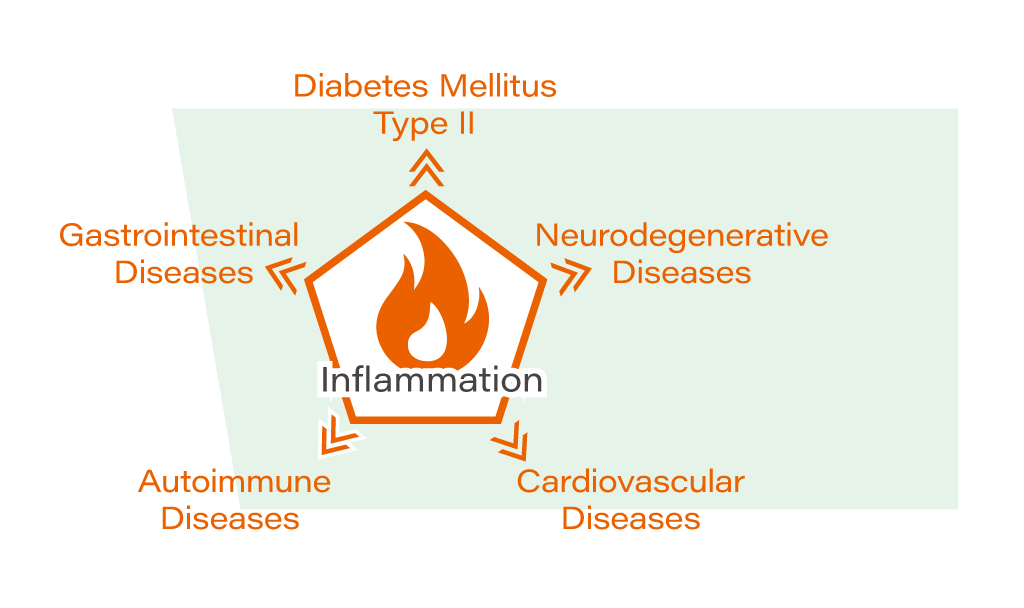
6. What is the richest source?
The sources of natural astaxanthin available in the market are salmon, krill, Phaffia yeast, and microalgae called Haematococcus pluvialis (H. pluvialis). Salmon and krill obtain astaxanthin from the food chain, and those are not the primary source. Wild-caught salmon is known as a good source of astaxanthin, however, in order to get 8 mg of astaxanthin per day, you will need to eat 400- 800 grams of salmon every day. And krill has issues for people who have a shellfish allergy.
So the best and safest natural source of astaxanthin is H. pluvialis. Nowadays, most of the natural astaxanthin manufacturers produce astaxanthin from this remarkable microalgae. H. pluvialis is a fresh water unicellular microalgae like Chlorella and Spirulina. It is plant-based, vegetarian friendly. But, there are quality differences even among astaxanthin sourced from H. pluvialis. So you need to check how and where the astaxanthin products are made.
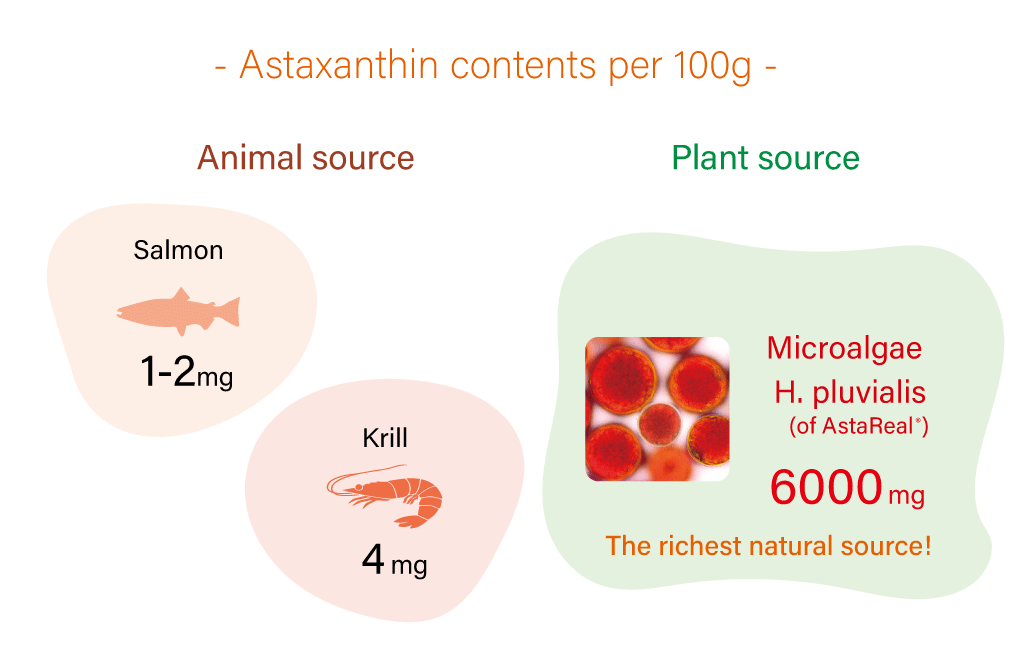
7. What kind of Human studies are done?
And how much should I take daily?
Fuji Chemical /AstaReal group supported more than 70 clinical studies on astaxanthin. Studies demonstrate the safety of astaxanthin at dosages from 2 mg to 45 mg/day. And various clinical studies on eye health, muscle endurance, cardiovascular health, skin health, and cognitive health had been conducted and proved the effective daily dose between 4-12 mg.
*We recommend checking your local regulations for recommended daily dosage.
The information provided on this page is for professional use only. Statements and information provided herein have not been evaluated by the Food and Drug Administration or other health authorities. This product is not intended to diagnose, treat, cure or prevent any disease. This website is accessible from many geographical locations, and the information that it provides regarding AstaReal® is not applicable to nor intended to satisfy the requirements of all countries. Fuji Chemical Industries supplies AstaReal® raw materials to companies that produce a variety of AstaReal®-containing products. Fuji Chemical Industries does not make any claims regarding the use of these finished products and each manufacturer is responsible for ensuring that the claims made for and use of its products comply with the regulatory requirement of the locations in which it markets its products.
with our know-how and science.

